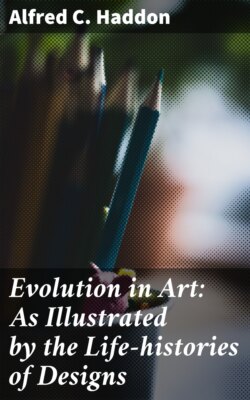Читать книгу Evolution in Art: As Illustrated by the Life-histories of Designs - Alfred C. Haddon - Страница 9
На сайте Литреса книга снята с продажи.
II.—The Fly River.
ОглавлениеTable of Contents
The Fly River is the largest river in New Guinea. It rises from about the area where the Dutch, German, and British territories abut, and flows into the western side of the Gulf of Papua. For a great part of its course it flows through low-lying and often swampy country, which is but sparsely inhabited, except in the delta region. For our present purpose we need only consider the delta and the middle region of the river. Owing to the carelessness of collectors, it is very difficult to determine from what exact district many objects labelled “Fly River” actually come.
The largest island in the delta of the Fly River is Kiwai, and this contains several villages. Almost the only objects which can be safely referred to Kiwai are the tubular drums with “jaws” at one end. There can be but little doubt that the carving represents the head of the crocodile, just as in the large Torres Straits and Daudai drum the “jaws” probably are derived from the same reptile. The carving on the Kiwai drums is boldly executed, and usually filled in with red and white pigment.
So far as I can discover, the etching on the bamboo tobacco-pipes is similar in many respects to that on those from the previous district, but the zigzag lines are usually much coarser, and the punctate line is either rare or absent.
In some of the islands in the delta of the Fly River, at Daumori for example, carved wooden slabs, more or less ovoid in contour, are suspended on the front of a house for good luck; some of these are also employed as figure-heads for canoes to ensure successful voyages. They have carved upon them conventional human faces, and occasionally whole figures, accompanied by simple patterns.[5]
Fig. 8.—Rubbing of one side of the decoration of a drum from the Fly River, in the Museum at Rome; one-fourth natural size.
Middle District of the Fly River.—The most extensive collection of objects at present in Europe from the interior of New Guinea along the Fly River is that in the museum in Rome. These were “collected” by Signor d’Albertis, mainly at what he named “Villaggio dei cocchi,” which is probably the same place reached by Sir William MacGregor on January 7th, 1890; it is situated about 380 miles from the mouth of the river.
The drums from this district differ in shape from those from other parts of the Possession, and a somewhat elaborate ornamentation is carved on them in low relief. The means do not at present exist for elucidating the significance of these designs (Fig. 8), which are compounded of crescentic lines, leaf-like and triradiate elements and spirals. Some of the figures certainly look as if they were intended to represent leaves; if this is the case, it may be due to some influence from the north, for we find that leaf-designs are employed in the north of Netherlands New Guinea. Dr. M. Uhle[6] states that “the influence of the plant ornamentation of the East Indian Archipelago is also found in West New Guinea. Although it is essentially characteristic of the western portion of the East Indian Archipelago, isolated examples are not wanting in the ornamentation of the eastern.” He thinks he can trace the plant motive in South-West New Guinea as far as Wamuka River.
The bamboo pipes are also decorated in a characteristic manner, the pattern being caused by a local removal of the skin of the bamboo, so that it shows darker against a light background. There is usually considerably more regularity in the decoration than occurs on the drums.
